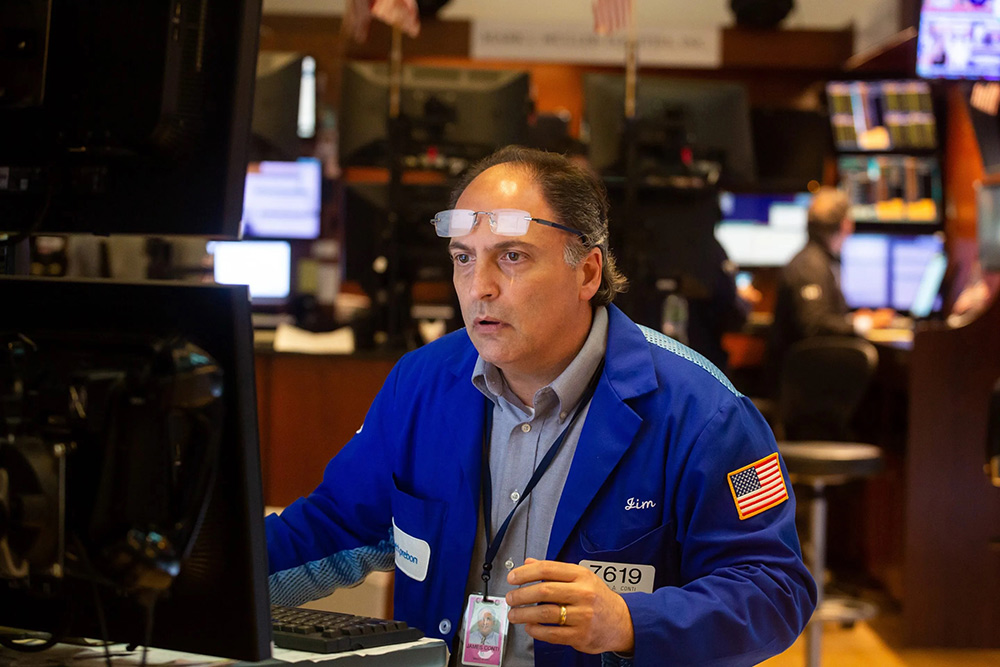华尔街情绪跌至5年最低,多数投资者认为美国将陷入衰退

过去一年多以来,华尔街的投资银行和经济学家们对于迫在眉睫的经济衰退,不断发出警告,而本周,美国银行(Bank of America)的数据显示,这些警告终于引起了投资者的关注。
由萨维塔·苏布兰马尼安领导的美国银行策略师在周三发布的一份研究报告中表示,市场认为美国今年陷入轻度衰退的可能性为80%,有30%的可能性陷入“全面衰退”。
与此同时,在7月,华尔街的情绪连续七个月下降,降至五年多来的最低水平。
美国银行的卖方预期指标(SSI)上个月下降至只有53.2%。该指标跟踪的是华尔街分析师在一个投资组合中推荐的股票配置平均水平。该指标较2021年初的最高点近60%大幅下降,但与15年平均水平55.3%相差不大。
奇怪的是,美国银行策略师认为,卖方分析师的情绪下降,可能并不是对股市而言最糟糕的因素。苏布兰马尼安和她的团队认为,当卖方分析师对股票感到悲观时,这可能是一个反向买入指标。
策略师们写道:“我们发现,在上世纪80和90年代的牛市以及2009年至2020年[的牛市],华尔街都推荐减持股票。”
美国银行的数据显示,历史上,当美国银行的卖方预期指标下降至当前水平或更低水平时,标普500指数在次年的回报率为正的概率是95%,相比之下该指数回报率为正的平均概率为82%。策略师们认为,如果该指标继续下降两个百分点,就代表了一个“买入”信号。
尽管该指标下降可能代表了反向买入信号,但美国银行对美国经济的基本判断依旧是今年下半年美国将陷入轻度衰退。该投资银行的策略师们表示,GDP连续两个季度萎缩,以及公司营收电话会议上频频提到的“需求疲软”,意味着股市的前景并不光明。
他们建议投资者在当前市场环境下采取防御性投资策略,专注于自由现金流稳健的公司,因为这些公司的股票在经济“后周期和下行阶段”通常有更好的表现。
投资者似乎已经开始削减股票投资。在美国银行7月发布的基金经理调查报告中,苏布兰马尼安和她的团队还指出,尽管7月股价上涨了9%,投资者对于其投资组合依旧持“看跌立场”,而现金水平提高到自2001年以来的最高水平。
不止美国银行注意到投资者开始变得有些悲观。瑞银集团(UBS)的最新调查也显示,第二季度,对美国经济和股市的短期投资者乐观情绪分别下降至39%和37%。
瑞银欧洲、中东与非洲区总裁伊克巴尔·汗在随着这项调查发布的一份声明中表示:“通胀高企、俄乌战争和经济衰退的可能性,令全球投资者感到担忧。”
投资者的悲观情绪也可能是消费者信心下降的结果。密歇根大学(University of Michigan)调查发现,消费者对美国经济现状的悲观情绪,远超过史上其他任何时间。消费者信心下降可能导致整个经济中的消费减少,这将是美国经济面临的一个严重问题,因为消费者支出约占美国GDP的三分之二。(财富中文网)
翻译:刘进龙
审校:汪皓
7月,华尔街的情绪连续七个月下降,降至五年多来的最低水平。摄影:MICHAEL NAGLE/新华社经盖蒂图片社提供
过去一年多以来,华尔街的投资银行和经济学家们对于迫在眉睫的经济衰退,不断发出警告,而本周,美国银行(Bank of America)的数据显示,这些警告终于引起了投资者的关注。
由萨维塔·苏布兰马尼安领导的美国银行策略师在周三发布的一份研究报告中表示,市场认为美国今年陷入轻度衰退的可能性为80%,有30%的可能性陷入“全面衰退”。
与此同时,在7月,华尔街的情绪连续七个月下降,降至五年多来的最低水平。
美国银行的卖方预期指标(SSI)上个月下降至只有53.2%。该指标跟踪的是华尔街分析师在一个投资组合中推荐的股票配置平均水平。该指标较2021年初的最高点近60%大幅下降,但与15年平均水平55.3%相差不大。
奇怪的是,美国银行策略师认为,卖方分析师的情绪下降,可能并不是对股市而言最糟糕的因素。苏布兰马尼安和她的团队认为,当卖方分析师对股票感到悲观时,这可能是一个反向买入指标。
策略师们写道:“我们发现,在上世纪80和90年代的牛市以及2009年至2020年[的牛市],华尔街都推荐减持股票。”
美国银行的数据显示,历史上,当美国银行的卖方预期指标下降至当前水平或更低水平时,标普500指数在次年的回报率为正的概率是95%,相比之下该指数回报率为正的平均概率为82%。策略师们认为,如果该指标继续下降两个百分点,就代表了一个“买入”信号。
尽管该指标下降可能代表了反向买入信号,但美国银行对美国经济的基本判断依旧是今年下半年美国将陷入轻度衰退。该投资银行的策略师们表示,GDP连续两个季度萎缩,以及公司营收电话会议上频频提到的“需求疲软”,意味着股市的前景并不光明。
他们建议投资者在当前市场环境下采取防御性投资策略,专注于自由现金流稳健的公司,因为这些公司的股票在经济“后周期和下行阶段”通常有更好的表现。
投资者似乎已经开始削减股票投资。在美国银行7月发布的基金经理调查报告中,苏布兰马尼安和她的团队还指出,尽管7月股价上涨了9%,投资者对于其投资组合依旧持“看跌立场”,而现金水平提高到自2001年以来的最高水平。
不止美国银行注意到投资者开始变得有些悲观。瑞银集团(UBS)的最新调查也显示,第二季度,对美国经济和股市的短期投资者乐观情绪分别下降至39%和37%。
瑞银欧洲、中东与非洲区总裁伊克巴尔·汗在随着这项调查发布的一份声明中表示:“通胀高企、俄乌战争和经济衰退的可能性,令全球投资者感到担忧。”
投资者的悲观情绪也可能是消费者信心下降的结果。密歇根大学(University of Michigan)调查发现,消费者对美国经济现状的悲观情绪,远超过史上其他任何时间。消费者信心下降可能导致整个经济中的消费减少,这将是美国经济面临的一个严重问题,因为消费者支出约占美国GDP的三分之二。(财富中文网)
翻译:刘进龙
审校:汪皓
Investment banks and economists on Wall Street have been warning about an impending recession for over a year now, and this week, data from Bank of America shows investors are starting to take notice.
Bank of America strategists, led by Savita Subramanian, said in a Wednesday research note that the market is pricing in an 80% chance for a mild recession and a 30% chance for “a full-blown recession” this year.
At the same time, Wall Street sentiment fell for the seventh consecutive month in July, hitting its lowest level in more than five years.
Bank of America’s Sell Side Indicator (SSI), which tracks the average recommended allocation to stocks within an investment portfolio from Wall Street analysts, dropped to just 53.2% last month. That’s down sharply from early 2021’s roughly 60% peak, but not far below the 15-year average of 55.3%.
Oddly enough, the falling sentiment from sell-side analysts may not be the worst thing for stocks, according to Bank of America’s strategists. Subramanian and her team argued that when sell-side analysts become pessimistic about equities, it can be a contrarian buy indicator.
“We note that Wall Street recommended underweighting equities through the entire bull market of the 1980s and 1990s as well as in [the bull market of] 2009 to 2020,” the strategists wrote.
Historically, when BofA’s SSI falls to current levels or lower, returns on the S&P 500 were positive 95% of the time over the following year, compared to an 82% chance of positive returns on average, Bank of America data shows. And if the indicator falls another two percentage points, it would begin to flash a “buy” signal, the strategists noted.
Despite the potential contrarian buy signal, Bank of America’s base case for the U.S. economy still involves a mild recession in the second half of this year. And the investment bank’s strategists noted that GDP contracting in the second quarter and soaring mentions of “weak demand” on corporate earnings calls make the outlook for equities less than rosy.
They recommended investors stick to defensive plays in this market environment and focus on companies with strong free cash flow, which tend to outperform during “late cycle and downturn phases” in the economy.
Investors also appear to already be cutting down on their stock investments. In a separate research note, Subramanian and her team also pointed out that even with stocks rising 9% in July, investors continue to position their portfolios in a “bearish stance,” with cash levels rising to highs not seen since 2001, according to the July BofA Fund Manager Survey.
Bank of America isn’t the only one to note that investors are starting to get a bit pessimistic. A new UBS survey also shows that short-term investor optimism about the U.S. economy and the stock market plunged to 39% and 37%, respectively, in the second quarter.
“Investors across the globe are concerned about the combination of higher inflation, the war in Ukraine, and the potential for a recession,” Iqbal Khan, president of UBS Europe, Middle East, and Africa said in a statement accompanying the survey.
Investors’ bearish stance could also be a result of plunging consumer sentiment. According to the University of Michigan, consumers are more pessimistic about the current state of the U.S. economy than at any other time in history. And falling consumer sentiment can lead to a pullback in spending across the economy, which can be a serious issue for U.S. economic growth given that consumer spending makes up roughly two-thirds of U.S. GDP.













